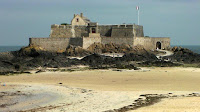 St Malo during the middle ages was a fortified island at the mouth of the Rance River. Modern Saint-Malo traces its origins to a monastic settlement founded by Saint Aaron and Saint Brendan early in the 6th century. Its name is derived from a man said to have been a follower of Brendan, Saint- Malo.
St Malo during the middle ages was a fortified island at the mouth of the Rance River. Modern Saint-Malo traces its origins to a monastic settlement founded by Saint Aaron and Saint Brendan early in the 6th century. Its name is derived from a man said to have been a follower of Brendan, Saint- Malo.
The weather today is cold, overcast and bleak. Rugged up in the warmest clothes we own, we boarded the tender boat for the ride to the dock. With the sound of seagulls above we climbed the stairs to start our walk on the old city wall.
 |
| Fort National St Malo France |

 |
| St Malo France |
The old city ‘Intra-Muros’ is on a point with forts surrounding the walked city. On low tide we walked across the beach to Fort National. During high tide the fortress is surrounded by the sea and inaccessible from the beach.
Click Read More below for more and photos……………
 Saint-Malo had a tradition of asserting its autonomy in dealings with the French authorities and even with the local Breton authorities. From 1490-1493, Saint-Malo declared itself to be an independent republic, taking the motto “not French”, not Breton, but Malouins”. The corsairs of Saint-Malo brought wealth from further afield. Jacques Cartier, who sailed the Saint Lawrence River and visited the sites of Quebec City and Montreal; and is thus credited as the discoverer of Canada, lived in and sailed from Saint-Malo, as did the first colonists to settle the Falklands-hence the islands French name Iles Malouines, which gave rise to the Spanish name Islas Malvinas.
Saint-Malo had a tradition of asserting its autonomy in dealings with the French authorities and even with the local Breton authorities. From 1490-1493, Saint-Malo declared itself to be an independent republic, taking the motto “not French”, not Breton, but Malouins”. The corsairs of Saint-Malo brought wealth from further afield. Jacques Cartier, who sailed the Saint Lawrence River and visited the sites of Quebec City and Montreal; and is thus credited as the discoverer of Canada, lived in and sailed from Saint-Malo, as did the first colonists to settle the Falklands-hence the islands French name Iles Malouines, which gave rise to the Spanish name Islas Malvinas.








